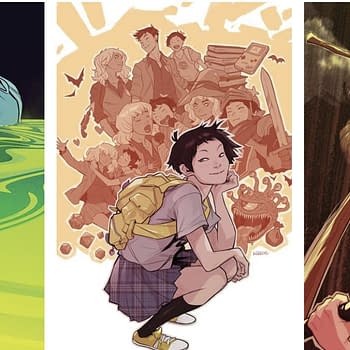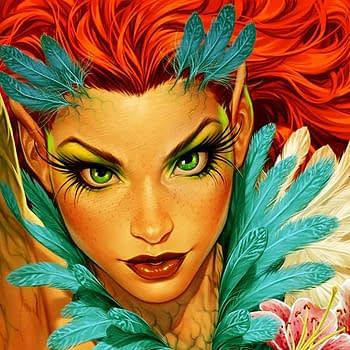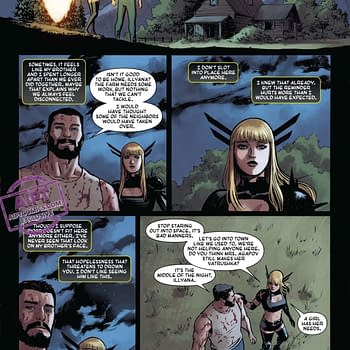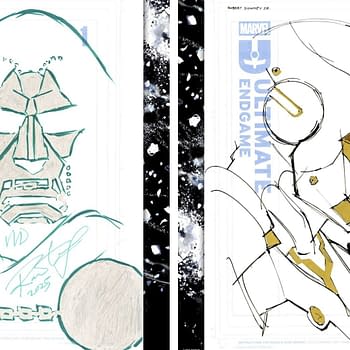Posted in: Comics | Tagged: black bat, Brian Buccellato, Comics, dynamite
The Black Bat Like You Have And Haven't Seen Before
The Black Bat #1 isn't officially out until May 8th this week, but Phantom Variants, for one, are already circulating, one of what I would definitively call a "crazy number" of variant covers, totalling 15. This may be a rare occasion, though, when such a number of variants are justified given the pulp hero tradition, steeped in evocative painted covers, of the character known as the Black Bat.
If you've heard of the Black Bat before, it may be because the 1939 pulp series, preceded by a similar title and character five years earlier, nearly came to legal fisticuffs with Detective Comics over striking similarities between the Black Bat and Batman, who first appeared in the same year. The matter was negotiated out of court on the premise that both companies would continue to publish their work despite the overlap, one in prose and the other in comics form.
Dynamite Comics have produced an updated version of the character based on the 1939 series in comics, and by staying as close to the pulp hero and storyline as possible, they have avoided similar modern lawsuits. But it wasn't simply a matter of clever legal planning on their part; there's a distinctive appeal to this original work, one which appears to have been mined by many other comics and companies in the years since its publication. If you think you're hearing echoes of Batman, or even of Daredevil, you are, but not following the chain of influence that you first suspect. Here we have a cousin or source for many later comic heroes and many of the tropes of "redemption" vigilante stories infused with noir elements.
Written by Brian Buccellato, whose previous credits include writing The Flash for the New 52, and working as a colorist on a host of comics, and drawn by Ronan Cliquet, who has a substantial following as a penciler for Marvel, The Black Bat has quite a cache of material to work with from the original pulp series. However, it also faces the challenge of rendering such a comic interesting enough that an over-familiarity with pulp traditions among reader nowadays won't make the book too predictable. Unfortunately, it would be all too easy for a translation of a pulp hero to feel parodic, at worst, simplistic at best.
Some of the formal elements of the comic definitely "work" as a comic in modern terms while still preserving a noir mystique. Cliquet's fight scenes are not simply blow-by-blows, but instead surreal renderings of movements, like in the preview image released by Dynamite depicting a circular depiction of fists grappling around the central overhead view of a lit space where a prisoner is being held. Cliquet gets a chance to bring out the noir influence not only in lighting, but in clothing, too, from a multitude of black-gloved individuals to the prevalence of dark suits. Gangster clothes never change, apparently, or at least, our expectations of them do not.

The comic also chooses not to follow strict linear time in its narrative, which was probably smart, helping throw the reader off the scent of things they think they know and recognize from other comics. Recognizable elements are a hero who wears black, often flowing garments, covers his head in a cowl of sorts, and identifies as a bat. Add to that the fact that he's ostensibly blind, though with unique abilities, and also an attorney, and you might think you're in Hell's Kitchen. But you're not. It's grittier, more basic, and less predictable than that, fortunately. But it's a still a comic that must grapple with the long history of comics that stands between the 1930's and 2013.
Some of this accommodation includes the occasional rather self-aware commentary upon the role of a hero and whether the Black Bat qualifies as a super hero. He has an alter ego, after all, and is on the mission of a vigilante to right his own wrongs performed as a shady lawyer previously. The possibility is quelled effectively by almost joyously returning to the mottos of hard-boiled detective fiction. Quinn does not believe he could ever be a hero, and neither do other people, it seems. His blunt commentary to the reader about what makes him tick, a few laudable emotions but mainly regret, place him firmly in the pulp detective tradition, and it looks like Dynamite wish to continue exploring that tension between hero and vigilante in future issues.
The Black Bat makes a lot of bold choices, but moderates them with a nod to tradition and what core elements made a pulp story about a man who dresses up but has unusually heightened visions and sense work initially. It's clear that Buccellato and Cliquet abide by the model, "If it ain't broke, don't fix it", but that's not to say they don't know how to introduce change when it is really necessary to tell an up to date story. What's more, after looking back to the 1939 Black Bat series for comparison, it's remarkable how close they stay to the original construction of the work without making the story seem wooden. It's a book with a lot of potential because it doesn't undermine its own origins by trying to be overly clever or sardonic about pulp tradition. It selects the best elements from the past Black Bat character and takes them for a spin to see what kind of attention it can still attract. From what I've seen, it stands a good chance of holding onto the fascination it establishes in issue #1, including some unusual revelations in its finale, to bring readers back for more of its seminal bat style vigilantism.
Hannah Means-Shannon is a comics journalist and scholar working on books about Alan Moore and Neil Gaiman for Sequart.org. She is @HannahMenzies on Twitter and @hannahmenziesblog on WordPress.












